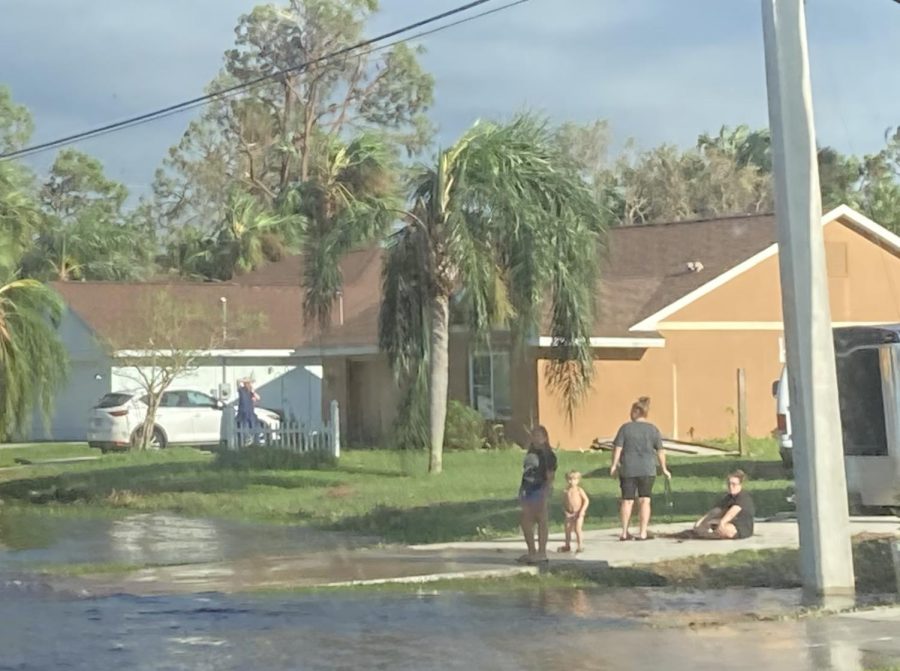The Devastating Effects of Hurricane Ian
The storm was the most destructive to hit Florida in 90 years.
"Hurricane Ian Aftermath in North Port, Florida 16" by PCHS-NJROTC is licensed under CC BY-SA 4.0.
Streets remain flooded throughout Florida
October 12, 2022
Florida is in shambles. Literally.
On September 19th, a tropical wave formed just a little east of the Windward Islands. This minor disturbance would soon become major, turning into Hurricane Ian.
The original track for this storm was headed west, right towards Florida. On September 24th, the storm was officially declared a tropical depression as winds began to reach 40 mph, and was named Ian. In the early morning hours of September 27th, Ian’s wrath hit western Cuba. The winds peaked at 125 mph and were only starting to get stronger in the Gulf.
This began to panic Floridians as Ian was predicted to reach category 4 strength. In southwest Florida, a category 4 hurricane had not made landfall in 17 years. Mandatory evacuations were issued for almost all of the Tampa coastal areas. On September 28th, Ian had further strengthened and had reached winds of 155 mph, right as it was approaching Florida.
Out of all of the places hit by Ian’s wrath, Florida was hit the hardest. On the day before the hurricane was supposed to hit, September 27th, there was a tornado outbreak throughout the Gulf Coast. A tornado in Boca Raton had an EF2 rating. A mandatory evacuation was issued for Hillsborough county. Florida governor Ron Desantis decided that it would be best to suspend all tolls in central-west Florida. After that, Desantis decided to issue mandatory evacuation orders for 11 more counties. As millions of people tried to evacuate, this caused extreme traffic congestion throughout Florida and Georgia.
On the afternoon of September 28th, Ian made landfall next to two popular tourist towns, Fort Myers and Cape Coral. As the 155 mph winds ravished the town, over two million people went powerless, and mandatory curfews were issued. As the rain poured, people became trapped in their homes. Storm surge reached a whopping 12 feet. People who lived in high rise apartments became trapped with no way down, putting full trust in the infrastructure of their buildings. People who live in houses had to resort to their second floor, or even their roof, because the water was so high. Mobile homes were uprooted and tossed like ragdolls. Over 2,000 flights from Florida, or heading to Florida, were canceled. Ian began to make its way towards central and eastern Florida to cause more catastrophic damage.
As Ian approached the Orlando area, it showed no signs of stopping. In Union Park, a town just a little northeast of Orlando, over 21 inches of rain fell . In downtown Orlando, over 15 inches of rain had fallen. Following the storm, 25% of the state would be powerless. The flooding throughout central Florida was unprecedented. On the east coast of Florida, over 20 inches of rain fell.
After hitting Florida hard, Ian returned to the Atlantic Ocean, aiming for the Carolinas. Two days later, as a Category 1 hurricane, Ian struck near Georgetown, South Carolina. Sustained winds reached 85 mph, and gusts near 94 mph in Shutes Folly, South Carolina. Water was up to calf-level, as streets were flooded and piers were ripped apart. The death toll climbed in the Carolinas because many resident didn’t take the warnings seriously. Many homes and boats on the coast were destroyed, causing people to be displaced. The remnants of Ian began moving north, hitting the coast of New Jersey. Atlantic City began using sirens to alert residents of imminent flooding. Many homes were damaged.
As of October 5th, remnants of Ian were still hitting the northeast. In Florida, DeSantis went door to door to homes that were hit the worst in his state. Many schools still remained closed last week. The current death toll is 125 people, with 120 deaths in Florida and five in North Carolina. Damages are estimated to be valued at approximately $67 billion.












